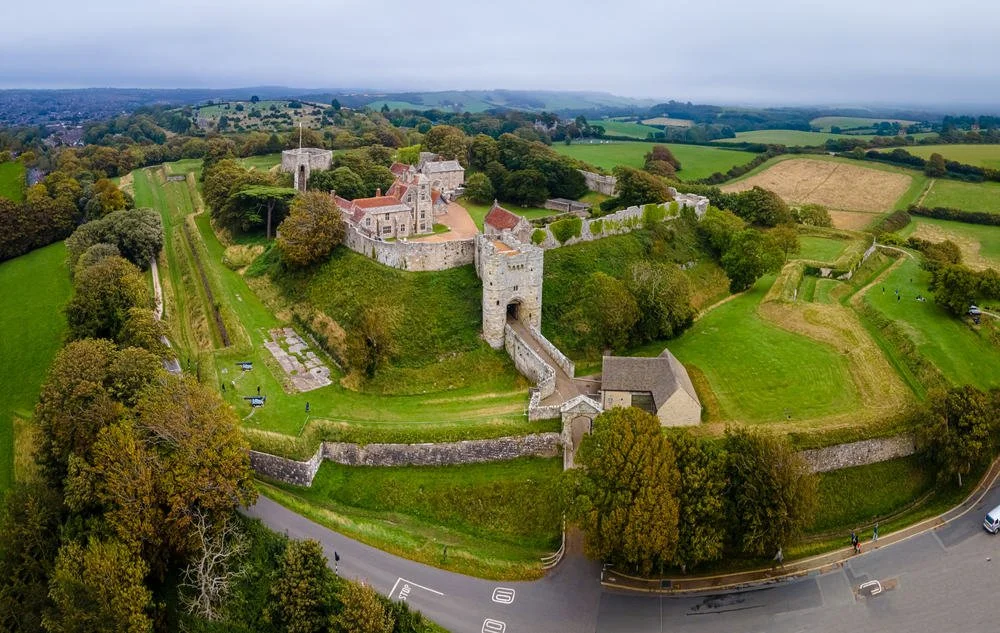Vikings, the Normans and the French Raid
Carisbrooke Castle | ‘Hundred Years’ War | The Medieval Lighthouse
Historical Places to Visit
Surprisingly, no Viking helmets or battle axes have turned up on the Isle of Wight—no archaeological trace of their rowdy pitstops has been found. Yet, history tells us the Vikings swung by in the late 10th and early 16th centuries, using the island as their temporary hideaway, perhaps to patch up their longboats or enjoy a quick pint before the next raid.
Castle Hill, Newport, Isle of Wight, PO30 1XY
Fast forward to the Norman Conquest (1066-71), and the island gets a new architectural showpiece—Carisbrooke Castle.
INSIDE THE CASTLE
Fancy a stroll? You can walk the same walls the King did for his daily exercise, imagining him muttering under his breath about the lack of escape routes. Then there’s the bowling green, thoughtfully laid out by Colonel Hammond, perhaps as a way to keep the King entertained while he plotted his next getaway attempt. Speaking of escapes, his most notorious effort came courtesy of a bedroom window—one he got himself thoroughly wedged in, much to the amusement of his page, Henry Firebrace, who gleefully documented the royal mishap. Nearly a year into his island staycation, the King was whisked back to the mainland, only to meet his grim fate in London in 1649.
Now, let’s rewind to the aftermath of the Norman Conquest.
William the Conqueror, fresh from his victory at Hastings, decided his relative William FitzOsbern, the 1st Earl of Hereford, needed something to keep him busy. FitzOsbern got the lordship of the island, and like any self-respecting Norman noble, he set about building a fortress. Carisbrooke Castle began to take shape, perched on a defensible spot in the heart of the island—a symbol of Norman dominance and a convenient way to keep the locals in check.
The castle remained in private hands for a good stretch of time, passed down through generations until the last of the line, Countess Isabella de Fortibus, was persuaded on her deathbed to part with it. For a tidy sum of £4,000, she handed the whole kit and caboodle—castle, land, rights, and all—to King Edward I in 1293. Not a bad deal for the Crown, and probably one of history’s savvier real estate transactions.
‘HUNDRED YEARS’ WAR
This particular purchase was quite the win for King Edward I, giving him a firm grip on the island’s defences—vital, given the French had developed a habit of swinging by uninvited during the 'Hundred Years' War.
In 1377, the French showed up again, merrily pillaging Yarmouth, Newtown, and Newport before deciding to try their luck with Carisbrooke Castle. However, the siege didn’t exactly go as planned. In true medieval plot-twist fashion, their commander was taken out by a single crossbow bolt fired from the castle’s west wall, and the French beat a hasty retreat. Not the heroic finale they were probably hoping for. These days, the castle enjoys a quieter life, now under the care of English Heritage, where the only invasions come from curious tourists.
THE MEDIEVAL LIGHTHOUSE
Blackgang, Isle of Wight, PO38 2JB
On a rather more modest scale, perched atop St Catherine's Hill near Blackgang, you’ll find the Pepperpot—a medieval lighthouse that looks more like a stone thimble than a beacon of maritime safety. A short 15-minute climb from the carpark will take you to this curious structure, built by a local landowner, Walter de Godeton, (who stole caskets of wine) after a shipwreck in Chale Bay caused quite the scandal
The Pepperpot once had a chapel attached, where a priest dutifully said masses for the unfortunate souls lost at sea. The lighthouse had a bit of an issue with visibility, as it turns out. Thanks to the island’s temperamental weather, low clouds often swallowed the light whole, rendering the poor Pepperpot about as useful as a chocolate teapot.
St. Catherine's Oratory (completed in 1328), also known as the Pepperpot. Image credit | Sam Jackson
Still, if there’s one thing the French raids taught the English, it was the dire need for proper defences. As Southampton grew into a bustling commercial port and Portsmouth became the Navy’s pride and joy, the Isle of Wight’s role as a defensive outpost became more urgent. After all, with the French perpetually lurking just across the Channel, a little extra fortification never hurt.



